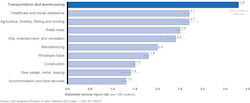On October 10, the Government Accountability Office (GAO) sounded the alarms about the safety of warehouse workers in light of the upcoming holiday season.
The agency notes that the number of employees supporting warehouses has doubled over the past few years to met the increase in E-commerce sales. And workers have experienced a growing number of serious injuries.
The agency's report on Sept. 18, "OSHA Should Take Steps to Better Identify and Address Ergonomic Hazards at Warehouses and Delivery Companies" found that warehouse and package delivery workers had the highest estimated rate of serious injury among private sector industries. On average, almost four in 100 full-time workers experienced serious injury in 2022.
Additionally, the rate of serious injury for these workers is getting worse, as rates warehouse increased 20% between 2018 and 2022. For last-mile delivery, the rate of serious injury rose by 23% during those same years.
Three categories of injuries accounted for about 85% of serious injuries among warehouse workers and 91% among last-mile delivery workers. These categories were:
- Overexertion. This was the most common category of injuries. It includes injuries and illnesses resulting from activities like excessive physical efforts, repetitive motion, and awkward or unnatural postures. The most common of these injuries were things like back strains from lifting heavy packages or repeated bending. Dislocated shoulders were another common injury in this category.
- Contact with objects and equipment. This was the second most common category of injuries and includes, for example, being hit by a forklift or a falling box. It does not include transportation-related accidents—such as a vehicle collision.
- Falls, slips, and trips. The third category of serious injuries includes falls from any height that result in serious injury, and things like slipping on a wet floor.
OSHA has increased its efforts to prevent hazards in warehouses and for last-mile delivery workers. During fiscal years 2018-2023, the agency cited warehouses and last-mile delivery employers for more than 2,500 workplace violations.
However, OSHA staff struggle to identify and address ergonomic hazards, the GAO noted. Often there was little training on these hazards and the guidance from OHSA was unclear.
The report offered the following recommendations to strengthen OSHA’s efforts:
- The Secretary of Labor should ensure that the Assistant Secretary of Labor for Occupational Safety and Health ensures that OSHA compliance officers can easily obtain data during inspections on when musculoskeletal disorders occurred. This could include adding a column for musculoskeletal injuries to OSHA recordkeeping forms.
- The Secretary of Labor should ensure that the Assistant Secretary of Labor for Occupational Safety and Health increases training on identifying and assessing ergonomic hazards for compliance officers who inspect worksites under OSHA's National Warehouse and Distribution Center Emphasis Program. This may include making elective ergonomic courses required courses for some officers; adding new courses or ergonomic components to existing courses; or making existing courses more accessible, for example, by increasing their frequency or offering them online.
- The Secretary of Labor should ensure that the Assistant Secretary of Labor for Occupational Safety and Health review and make needed changes to OSHA's internal and publicly available guidance that compliance officers and employers use to identify, assess, and address ergonomic hazards. This may include clarifying existing guidance and providing more current, industry-specific guidance.
- The Secretary of Labor should ensure that the Assistant Secretary of Labor for Occupational Safety and Health conducts timely follow-up with establishments that were issued an ergonomic hazard alert letter, as required by OSHA policy, to determine if establishments have taken corrective actions. This may include regional offices developing formal procedures for tracking ergonomic hazard alert letter.
- The Secretary of Labor should ensure that the Assistant Secretary of Labor for Occupational Safety and Health: (1) formally evaluates how well OSHA's national emphasis program for warehouses and distribution centers helps compliance officers identify, assess, and address ergonomic hazards; and (2) determines and documents next steps to correct any deficiencies detected.





